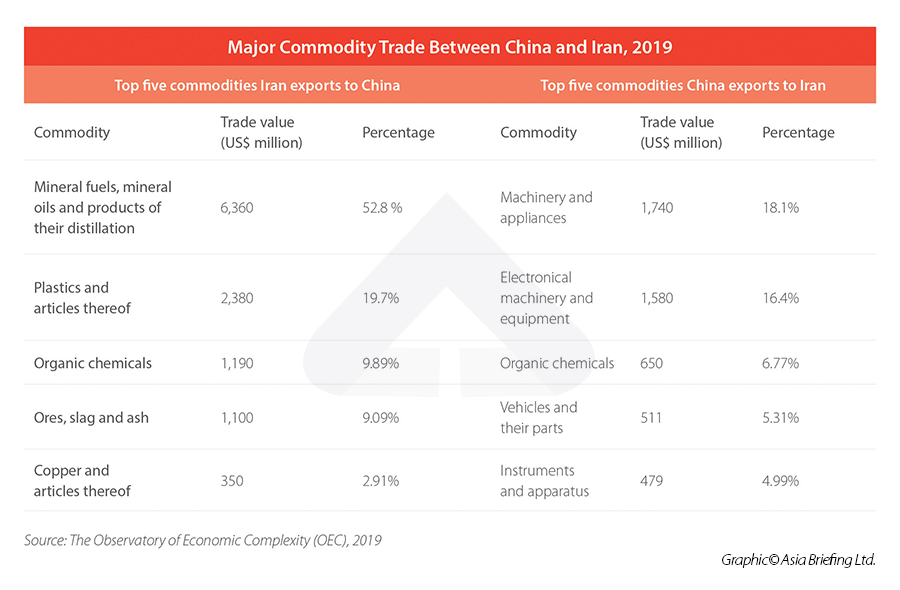China and Iran: Bilateral Trade Relationship and Future Outlook
Iran is an important economic and trade partner for China in the Middle East. China’s trade with Iran dates back to the ancient Silk Road in the first century BC. In recent years, the two countries have maintained regular high-level contacts, and bilateral economic and trade cooperation has continuously deepened. Iran is also an important overseas investment and project contracting market for China besides a key source of its energy imports.
China-Iran relations
China and Iran officially established economic ties in 1937, which were reaffirmed as the countries established their modern forms of government in 1949 and 1979, respectively. Bilateral diplomatic and trade relations have remained steady ever since, built largely on Iran’s abundant natural resources and China’s demand for oil. The two countries have cooperated on a wide range of projects in multiple sectors, including energy, technology, defense, and infrastructure.
In 2019, Iran approved visa-free travel to the country for Chinese nationals, including Hong Kong and Macao residents, possibly as a means of allowing Chinese travelers to visit the country without being penalized by US sanctions. Iran has also been a vocal supporter of China on the international stage, backing it in key international forums, such as the UN.
Iran and China have strengthened diplomatic and economic ties and bilateral trade in recent years, despite sanctions placed on Iran by the international community. In 2016, Xi Jinping became the first world leader to visit Iran after the signing of the Joint Comprehensive Plan of Action in 2015, more commonly known as the Iran nuclear deal, which China was party to. Since the Trump administration withdrew from the plan and reinstated sanctions in 2018, China has repeatedly called for the US to return to the negotiating table, offering to play a mediating role in discussions.
The sanctions have hurt bilateral trade between China and Iran since their reinstatement in 2018. However, more recent activity between the two countries suggests a determination to advance trade and investment despite the restrictions. To this day, China is Iran’s largest trade partner and major source of investment. In 2019, Chinese companies poured US$3.41 billion in direct investment into the country and signed contracts worth a combined US$3.11 billion, according to China’s Ministry of Commerce (MOFCOM).
China remains Iran’s largest buyer of Iranian crude oil, which is one of Iran’s largest exports. This trend appears to have picked up speed again in 2021, with Chinese imports of crude oil growing despite US sanctions.
Significantly, China and Iran reached a 25-year strategic cooperation agreement in March 2021. As part of the agreement, China is to invest US$400 billion into infrastructure projects in Iran, cementing Iran’s position as a critical link along the ‘New Silk Road’ of China’s Belt and Road Initiative (BRI), and paving a new path for bilateral trade and cooperation. Both sides have been low key about the specific commitments alluded to in the agreement, whose objective is likely primarily to create a facilitative environment for Sino-Iranian trade and business.
Trade flow between China and Iran
Over the last two decades, China has emerged as Iran’s biggest trading partner, with the total volume of trade between the two countries amounting to over US$20 billion annually.
According to Chinese Customs statistics, in 2019, bilateral trade between China and Iran amounted to US$23.02 billion. That was already a sharp drop of 34.5 percent from 2018, due to the US sanctions.
As a major industrial supplier to Iran, China mainly exports electrical machinery, broadcasting equipment, vehicle parts, organic chemicals, and rubber tires to Iran. In 2019, China exported goods worth of US$9.59 billion to Iran, down 31.6 percent year on year.
Iran’s share in Chinese international trade is much less significant, making up 0.5 percent of China’s total foreign trade. In 2019, Iran exported US$13.43 billion worth of commodities to China, down 36.4 percent year on year. The main products that Iran exported to China is crude oil, ethylene polymers, and iron ore.
Although Washington’s withdrawal from the Iran nuclear deal in May 2018 and the re-imposition of the US sanctions on Tehran hit China’s imports of crude oil from Iran, China remains the biggest buyer of Iranian crude oil.
In turn, Iran is China’s seventh largest source of oil imports. Throughout 2019, China imported US$7.155 billion worth of crude oil from Iran, accounting for about 6.3 percent of China’s crude oil imports.
Trade agreements between China and Iran
Bilateral investment treaty (BIT)
China and Iran signed a bilateral investment agreement in June 2000, which came into force on January 7, 2005.
As BITs set out terms and regulations for private investors in the partner country, an important function of BITs is providing protection and guarantees for both individuals and companies in the host country. These are provisioned in addition to protections already guaranteed under a host country’s domestic laws and include mechanisms for foreign investors to raise and settle disputes in a neutral court should the host country fail on its obligations to protect their rights.
The existence of the China-Iran BIT guarantees that investors and companies from both countries receive the same treatment by the host country as that awarded to domestic investors or investors from a third country.
Avoidance of double taxation
China and Iran signed an agreement for the avoidance of double taxation and the prevention of fiscal evasion with respect to taxes on income on April 20, 2002, which came into effect on August 14, 2003, and became applicable starting January 1, 2004.
From an investor’s perspective, confusion about international taxation can arise when investors are subject to two different and potentially conflicting tax systems.
The existence of the China-Iran DTA not only provides certainty to investors regarding their potential tax liabilities but also acts as a tool to create tax-efficient bilateral investments where applicable.
Trade opportunities between China and Iran
China is Iran’s largest trading partner and overseas export destination, while Iran is one of the most important oil exporters to China.
Chinese investment in infrastructure projects could properly assimilate Iran into the Belt and Road Initiative (BRI) as a transit point between Asia, Europe, and the Middle East.
Project contracting is a highlight of China-Iran economic and trade cooperation. Chinese enterprises have contracted many large-scale construction projects in Iran, involving water conservancy, transportation, energy, steel, and petrochemical, among others. Chinese companies acting as general contractors have led Chinese manufacturers in related industries to export complete equipment and mechanical and electrical products to these large construction projects in Iran.
Future exports and imports among Eurasian countries could be made simple with Iran joining the BRI. However, to make it happen, Beijing will need to strike a balance between its ties with Tehran and the rest of the Middle East, where it is also seeking partnerships – China is Saudi Arabia’s largest trading partner and Israel’s second largest, both of whom consider Iran their chief geopolitical threat.
The bigger picture
Prolonged US sanctions and COVID-19 has pushed the Iranian economy into dire straits. Despite being among the world’s largest oil producers and exporters, Iran saw its exports – its main source of income – plummet since 2018. The sanctions imposed by former US President Donald Trump threatened to cut off access to the international banking system for any country that did business with Iran.
Although the sanctions failed to achieve its stated goal of compelling Iran to agree to more restrictions on its nuclear program and to limit its influence in the Middle East region, they have suffocated the Iranian economy. In such a scenario, China has emerged as a reliable and irreplaceable trade partner for Iran. China has the technology and appetite for oil that Iran needs, suggesting a mutually beneficial relationship is possible. (In 2017, China replaced the US to become the world’s largest oil importer.)
Moreover, both China and Iran have an interest in expanding their technology and innovation footprint in emerging and underdeveloped markets, in turn exercising influence and building room for strategic cooperation. In January this year, Iran officially inaugurated the Iran House of Innovation and Technology (IHIT) in the Kenyan capital of Nairobi. As per reporting by the Tehran Times, the IHIT will serve as a “base for the creation of innovative ideas, the commercialization of these ideas, and the export of Iranian knowledge-based products and services to the East African market.” China has ample experience in spreading its tech and innovation expertise, and future collaboration between the two countries in third markets should not yet be written out.
How that takes shape, if it will at all, may be influenced by geopolitical considerations, such as the fate of the Joint Comprehensive Plan of Action (JCPOA) and potential roll-back of US sanctions on Iran.
According to the MOFCOM’s advice to Chinese investors, at present, there are many uncertainties in Iran’s economic and social prospects due to the dual impact of the US sanctions and the COVID-19 pandemic. Enterprises undertaking projects or investing or trading in Iran should fully consider sanctions risks, commercial risks, and security risks, and conduct relevant cooperation prudently and in an appropriate and orderly manner to effectively protect the safety of personnel and property.
This article originally appeared on China Briefing
About Us
Middle East Briefing is one of five regional publications under the Asia Briefing brand. It is supported by Dezan Shira & Associates, a pan-Asia, multi-disciplinary professional services firm that assists foreign investors throughout Asia, including through offices in Dubai (UAE), China, India, Vietnam, Singapore, Indonesia, Italy, Germany, and USA. We also have partner firms in Malaysia, Bangladesh, the Philippines, Thailand, and Australia.
For support with establishing a business in the Middle East, or for assistance in analyzing and entering markets elsewhere in Asia, please contact us at dubai@dezshira.com or visit us at www.dezshira.com. To subscribe for content products from the Middle East Briefing, please click here.



